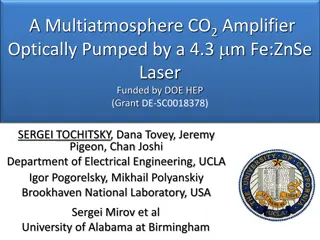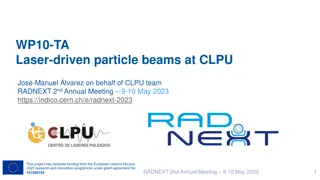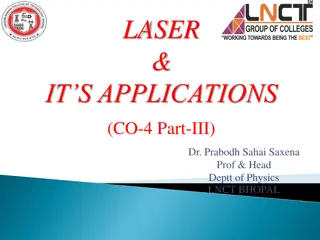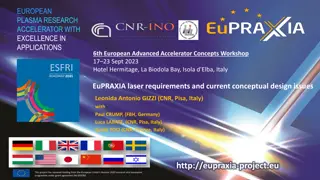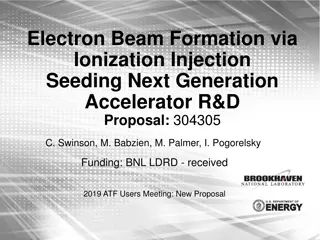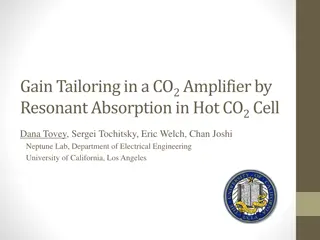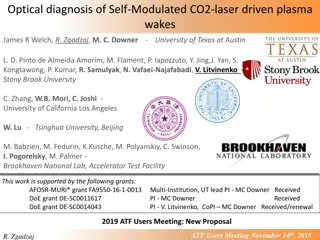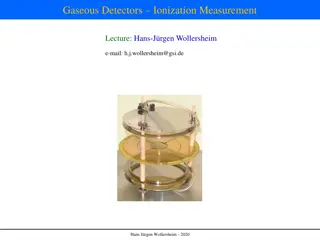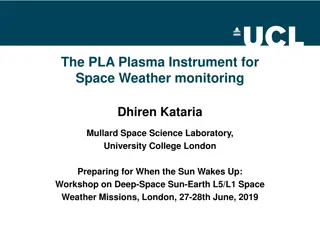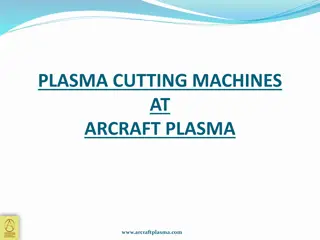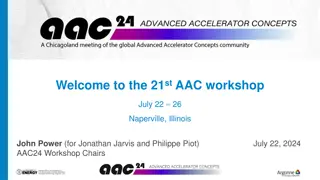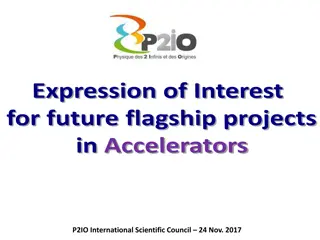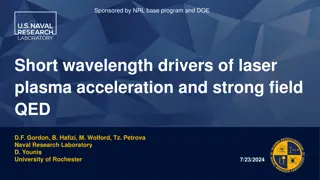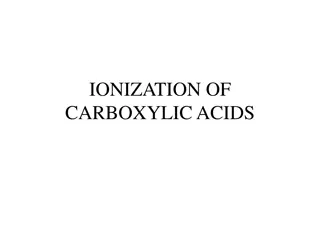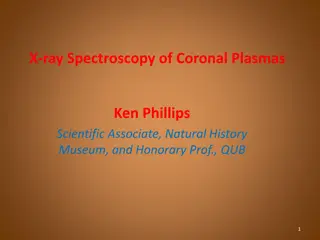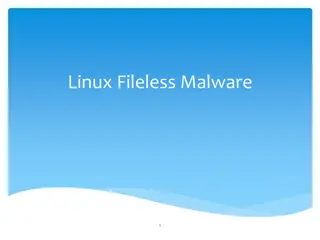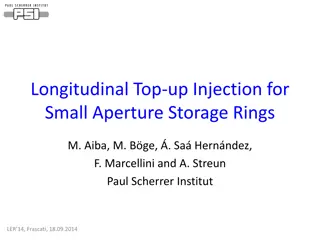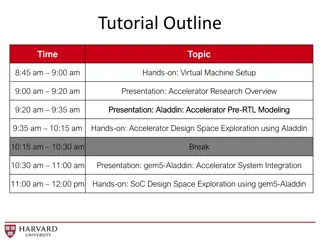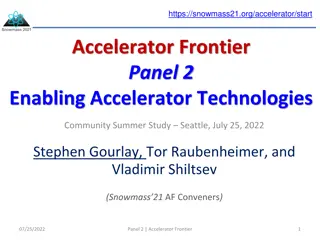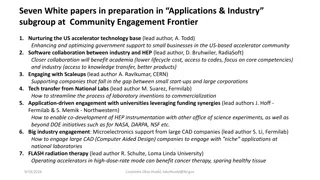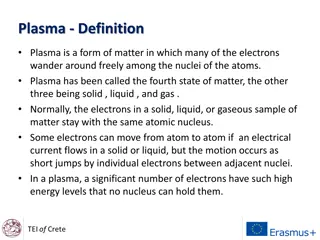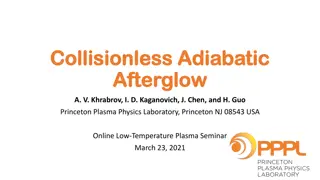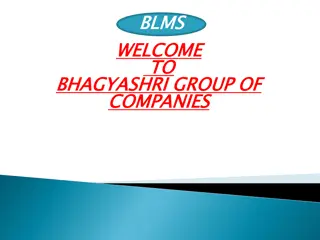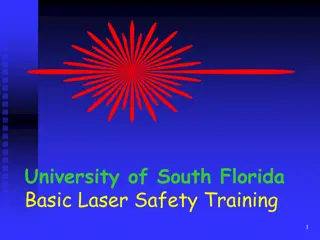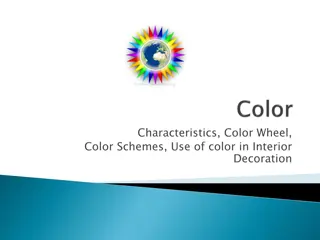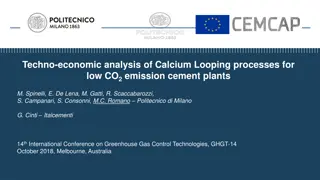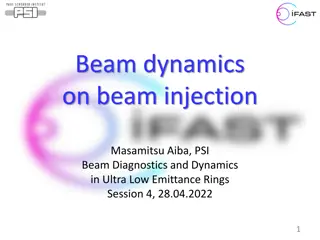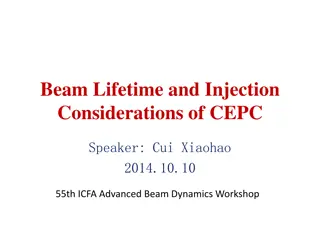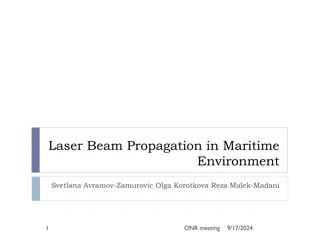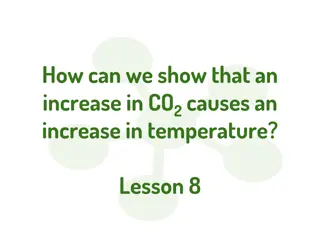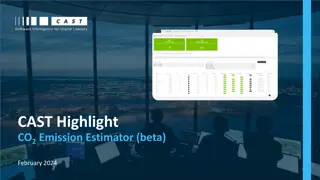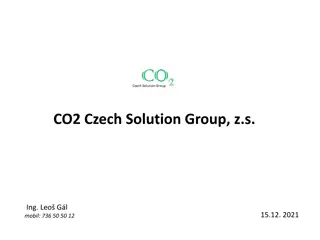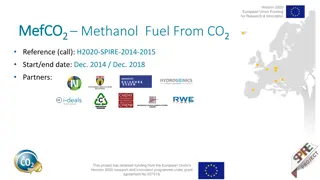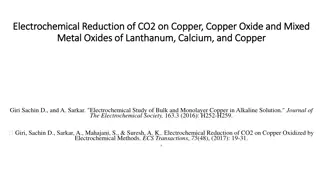Two-Color Ionization Injection Experiment Using CO2 Laser-Plasma Accelerator
This experiment conducted at ATF II focused on generating beams with ultra-low transverse emittance utilizing two-color ionization injection with a CO2 laser-plasma accelerator. The technique involves using a pump laser pulse in circular polarization and an injection laser pulse in linear polarization to achieve remarkable results. Technical considerations, parameter sensitivity, and prospects for a compact sub-100 nm emittance diagnostic were explored in detail.
Download Presentation

Please find below an Image/Link to download the presentation.
The content on the website is provided AS IS for your information and personal use only. It may not be sold, licensed, or shared on other websites without obtaining consent from the author. Download presentation by click this link. If you encounter any issues during the download, it is possible that the publisher has removed the file from their server.
E N D
Presentation Transcript
Two-color ionization injection experiment using a CO2 laser-plasma accelerator at ATF II C. Schroeder, C. Benedetti, J. van Tilborg, C. Geddes, E. Esarey, W. Leemans Lawrence Berkeley National Laboratory ATF Users Meeting, BNL, Oct 1-2, 2015 Office of Science UNIVERSITY OF CALIFORNIA 1 1
Outline Outline Concept of two-color ionization injection: <100 nm normalized transverse emittance Example of two-color ionization injection using CO2drive laser and Ti:Al2O3ionization laser Technical/practical considerations: parameter sensitivity Prospects for a compact sub-100 nm emittance diagnostic Office of Science UNIVERSITY OF CALIFORNIA 2 2
Laser field: Ponderomotive force: Ionization rate: L.-L. Yu, E. Esarey, et al., SPIE Conf. Proc. (2013) L.-L.Yu et al., PRL (2014) Xu et al., PRST-AB (2014) C. Schroeder et al., PRST-AB (2014) C. Schroeder et al., SPIE Conf. Proc. (2015) Office of Science UNIVERSITY OF CALIFORNIA 3 3
2-color ionization injection generates beams with ultra-low (tens of nm) transverse emittance Pump laser pulse (circular-polarization): a=1.2, 5 um wavelength 92 fs (rms), 36 um spot Injection laser pulse (linear-polarization): a=0.1, 0.4 um wavelength 16 fs (rms), 5 um spot plasma: Krypton gas, 2x1017 cm-3 Modeled using 3D PIC (WARP) 20 nm emittance C. Schroederet al., Phys. Rev. ST Accel. Beams. 17, 101301(2014) transverse momentum (p/mc) = 20 nm Ultra-low (tens of nm) emittance achievable using two-color ionization injection Office of Science UNIVERSITY OF CALIFORNIA 4 4
2-color ionization injection: CO2 drive laser ng = 1.25x1015cm-3 Gas jet: (L~0.5--1 cm) Krypton ne = 1016 cm-3 Ti:Al2O3 Ionization laser a0 Hs-Hi >0 Ez/E0 CO2Drive laser a1 Soon to be available at BNL - ATF-II [I Pogorelsky and I. Ben-Zvi, PPCF (2014)] CO2pump laser pulse: a0=2 10 um wavelength 470 fs (FWHM intensity) 155 um spot (ZR = 7.5 mm) P=20 TW (P/Pc=1) (linear polarization) 10 J Kr9+ Kr8+ E1 E0 Ti:Al2O3(frequency-doubled )injection laser pulse: a1=0.13 0.4 um wavelength 118 fs (FWHM intensity) 20 um spot (ZR = 3 mm) 114 mJ delay= 1.6 ps kp (z-ct) Office of Science UNIVERSITY OF CALIFORNIA 5 5
2-color ionization injection: CO2 drive laser Gas jet: (L~1 cm) Kr CO2pump laser pulse: a0=2 10 um wavelength 470 fs (FWHM intensity) 155 um spot (ZR = 7.5 mm) 10 J frequency-doubled Ti:Al2O3injection pulse: a1=0.13 0.4 um wavelength 118 fs (FWHM intensity) 20 um spot (ZR = 3 mm) 114 mJ Ti:Al2O3 Ionization laser CO2Drive laser ne = 1016 cm-3 final emittance in laser polarization plane (~ thermal emittance): Normalized emittance (nm) PIC = 80 nm PIC final emittance out of laser polarization plane: = 42 nm z (mm) Office of Science UNIVERSITY OF CALIFORNIA 6 6
2-color ionization injection: CO2 drive laser Gas jet: (L~1 cm) Kr PIC simulation Normalized emittance (nm) Ti:Al2O3 Ionization laser CO2Drive laser ne = 1016 cm-3 CO2pump laser pulse: a0=2 10 um wavelength 470 fs (FWHM intensity) 155 um spot (ZR = 7.5 mm) P=20 TW (P/Pc=1) (linear polarization) 10 J Propagation distance, z (mm) RMS energy spread Energy [MeV] Ti:Al2O3(frequency-doubled )injection laser pulse: a1=0.13 0.4 um wavelength 118 fs (FWHM intensity) 20 um spot (ZR = 3 mm) 114 mJ delay= 1.6 ps Charge [pC] pC 62 MeV 5% (rms) z = m Propagation distance, z (mm) Office of Science UNIVERSITY OF CALIFORNIA 7 7
Optimization: charge vs emittance C. Schroeder et al., PRST-AB (2014) C. Schroeder et al., SPIE Conf. Proc. (2015) charge: points = PIC Charge Q[pC] wi (mm) ionization laser spot size (um) Office of Science UNIVERSITY OF CALIFORNIA 8 8
Technical/practical considerations for 2-color ionization injection experiment Sensitivity to plasma wakefield amplitude - CO2laser driver amplitude and duration Sensitivity to timing/jitter between CO2 and Ti:Al2O3lasers - Increased ionization laser duration (energy) relaxes timing requirements Performance with ionization laser with 0.8 micron wavelength Interaction geometry: - co-linearity of lasers - required pointing - required alignment Measurement of <100 nm emittance: single-shot, energy-resolved emittance diagnostic Office of Science UNIVERSITY OF CALIFORNIA 9 9
Trapping requires weakly-relativistic wakefields Wakefield amplitude required to trap: Normalized laser intensity, a trapping trapping laser energy (J) Normalized laser duration FWHM laser duration (fs) Office of Science UNIVERSITY OF CALIFORNIA 10 10
Synchronization and jitter: ~100 fs timing desired 1.6 ps a0 Hs-Hi >0 Ez/E0 Operate at 1016 cm-3 with ~500 fs (FWHM) CO2 pulse ~1.6 ps delay between CO2 and Ti:Al2O3 a1 Trapping wake phases: t~500 fs ~0.5 ps kp (z-ct) Optical synchronization achieved by seeding Ti:Al2O3 using solid-state front-end of CO2 amplification chain Longer (more energetic) ionization laser can relax timing/delay sensitivity Office of Science UNIVERSITY OF CALIFORNIA 11 11
Performance using 0.8-micron ionization pulse: larger emittance in laser-polarization plane Efficiency of 2- generation (~30-50%) may limit energy in ionization pulse For fixed gas: CO2pump laser pulse: a0=2 10 um wavelength 470 fs (FWHM intensity) 155 um spot (ZR = 7.5 mm) P=20 TW (P/Pc=1) (linear polarization) 10 J Ti:Al2O3injection laser pulse: a1=0.26 0.8 um wavelength 118 fs (FWHM intensity) 20 um spot 114 mJ delay= 1.6 ps Charge (pC) ionization laser spot size (um) Office of Science UNIVERSITY OF CALIFORNIA 12 12
Interaction geometry: pointing and alignment tolerances Ti:Al203 C02 Gas jet 90-degree interaction reduces bunch charge: charge = (interaction volume) x (gas density) - Co-propagating: (volume) ~ w2 ZR - 90-deg: (volume) ~ w2 (TLc) charge reduced by ~(cTL)/ZR To avoid injection over larger transverse area (proportionally increasing emittance): - Pointing tolerance: mradfor 20 micron spot, 0.4 micron wavelength Alignment tolerances: - xm< 4 um Office of Science UNIVERSITY OF CALIFORNIA 13 13
Emittance diagnostic: single-shot, energy-resolved beam size measurement Geometric emittance: ~10-10 m Consider lens scan for emittance measurement: m few um Plasma-based discharge-capillary to provide symmetric, variable, high-field gradient (solenoid) lens J. van Tilborg et al., PRL (submitted, 2015) Weingartner et al., PRST-AB (2012) x m] Dispersed beam at screen x m] y m] Screen y m] dipole z[m] Energy [MeV] (transverse position on screen) end of LWFA: 27 pC, 62 MeV, 5% (rms) energy Discharge-cap lens: 1 cm length, 200 micron radius, 46 A, ~230 T/m measurement requires ~micron resolution at screen -wave-plate for Ti:Al2O3 to vary laser polarization and measure x, y-planes Office of Science UNIVERSITY OF CALIFORNIA 14 14
Summary Summary Two-color ionization injection using CO2 drive laser and Ti:Al2O3 ionization laser: produces e-beam with tens of nm normalized transverse emittance, tens of pC charge Emittance diagnostic: single-shot, energy-resolved measurement of beam size using plasma-based discharge-capillary lens ATF-II ideal facility to test concept Office of Science UNIVERSITY OF CALIFORNIA 15 15



